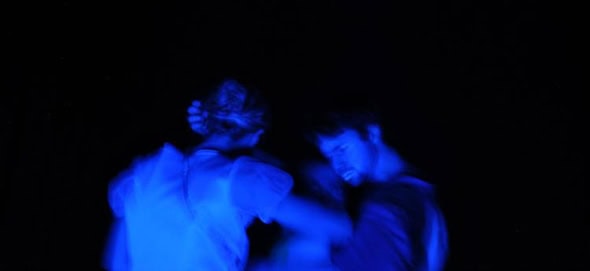Lola Maury, BROUHAHA, The Place
Posted: June 24th, 2019 | Author: Nicholas Minns | Filed under: Performance | Tags: Alberto Ruiz Soler, Alexander Standard, Ben Moon, Cesca Dvorak, Juan Corres Benito, Laureline Richard, Lola Maury | Comments Off on Lola Maury, BROUHAHA, The PlaceLola Maury, BROUHAHA, The Place, May 29

According to the Oxford English Dictionary, a brouhaha is ‘a noisy and overexcited reaction or response to something’, but the opening of Lola Maury’s BROUHAHA prompts an opposite reaction; as we sit on three sides of the stage at The Place waiting in the dark for what we think might be the beginning of the performance, nothing happens. Has something gone wrong? Then as we accustom our eyes to the darkness and our ears to the silence, we hear a prolonged whistled note from somewhere in the auditorium, and then another with eerie harmonics and the sound of Big Ben chiming in the fog. A sense of relief ensues as the notion of a beginning takes formal shape; the whistled harmonics are like reeds blowing in the night and from a single corner light we can ascribe their source to a trio of performers (Juan Corres Benito, Laureline Richard and Alexander Standard) arriving slowly on the still-overcast stage with rasping intakes of breath. What sounds come from the performers and what are embedded in Alberto Ruiz Soler’s ruminative, diaphanous score is difficult to tell, but Maury and her team seem to be setting up a theme of acclimatization that tests not only our senses but our expectations of what a performance might be. What we hear evolves into what we see: three evanescent figures flecked in silver slowly evolving under a brooding light. The trio naturally draws our focus but it is the scenic interplay of form, sound and light that vies constantly for attention. Ben Moon’s lighting corroborates Ruiz Soler’s growling collage of sounds while the layered forms of Cesca Dvorak’s gender-neutral costumes shroud the body in mystery.
Maury’s description of the work as ‘a multi-layered experience; a sometimes chaotic, sometimes harmonious mess of sonics mashed, spliced and woven which chimeric sequences of movement’ seems almost too defined. The smooth articulation of the performers is independent of any known narrative and defies any recognisable relationships; whether it suggests amoebas expanding their reach in a protoplasmic effort to survive or simply an imaginative deconstruction of formality, the very ambiguity of the spectacle spawns inevitable attempts at interpretation that are never allowed to coalesce into a cogent frame. At one moment one could imagine three children playing in a field at night or be reminded of the tidal interaction of waves; on a more comprehensive scale, we might think of the work as relating to space and time in an era before our definitions of such notions began to measure, control, change and transform them. Or is Maury channelling a response to the Anthropocene by layering corporal landscapes, seascapes and cityscapes on to one another in a brouhaha of vertebrate chaos?
While it is usual for dance movement to guide or be guided by the rhythm and melody of a score, Maury enlists Ruiz Soler’s soundscape to influence the dynamic shape and volume of her choreography. Integral to his rumbling leitmotif is the muscularity and vitality of extrinsic sounds — be it a music box, traces of ritual chanting or spoken word — entering the space as swirling matter that the performers imbue with their own articulation. But the relationship between performers and sound is porous; voices within the score imperceptibly manifest in the voices on stage and vice versa so that aural stimuli never appear long enough or clearly enough to generate a specific picture or image. It’s as if Maury and her creative team are keeping their own interpretive involvement as neutral as possible to allow the audience to see through the sound and to hear through the movement. BROUHAHA is clearly the fruit of a rich, organic collaboration and in bringing together its diverse threads, meanings and significations its performance is an acutely meditative experience.
Having taken us on this journey, it is the performers who assume the responsibility for resolving the brouhaha by vocalising, as it were, their own demise until the stage empties and falls silent. The audience’s applause is an abrupt reminder of space and time.